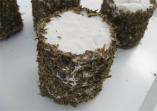I keep remembering Ruth Reichl’s closing words when she spoke at the Food & Morality-themed Oxford Symposium a couple of years ago: how where food is concerned, most of us want to do the right thing, if only we could figure out what that was. Vegetable oil labelling certainly makes it harder to do right by your salads.
From a health standpoint, extra virgin olive oil should be one of those right things, as long as it’s fresh when you get it and that you use it fairly quickly (regrettably most olive oil producers do not provide a harvest date on their labels).
Here’s a comforting article about why it’s worth paying more for good olive oil. Which usefully explains a bit about pomace oil, something I have seen on proudly labelled on sale in a few places here, and which I suspect few consumers know much about. And all that got me back to thinking about olive processing, which is a complex and many-layered subject.
Pomace oil is the cheapest possible kind of olive oil, on a par with industrial refined olive oil used for blending by the food industry. It was historically the lowest grade of oil: used for lamp oil, soap making or lubricating machinery.
Pomace is the residue of olive oil pressings: the pits and pulp of the olives, and is variously used as fuel, herbicide, animal feed, road building material, or mulch. But it may also be treated with solvents – because there’s not much extractable oil left – to extract the last of the oil, and then refined to make it edible.
Which from a nutritional and flavour standpoint makes this no better than other refined vegetable oils, (“refined” here is a manufacturing process and not a value judgement!) which are not “extracted only by mechanical means” as extra virgin olive oil is.
It’s the chemicals and heat which cause refined oils to have less character and nutritional value than cold-pressed oils. There have as well been health risks reported from consuming pomace oil.
But industrial olive processing has created some new problems: pollution and water consumption. For speed and convenience, the new olive oil extraction processes involve injecting water into the first of two, or sometimes three, phases of pressing, using centrifugal drums. The oil emulsifies with the water into a paste that emerges from the first phase and needs to be treated again, with more water, to separate them.
The so-called “vegetable waters” that result from this separation are contaminated with the inedible compound oleuropein in olives (try eating one off a tree sometime to understand the term “inedible”), and are considered toxic. This water is a major polluting by-product of olive production, whether for oil or for eating (eating olives must be repeatedly soaked and rinsed or brined to make them edible), and nobody has managed to work out a way of re-using this substance; worse, it can contaminate water supplies by seeping into groundwater.
“Vegetable waters” are not toxic in the way that chemical treatments are toxic, since they’ve been produced only by combining olives and water: but if dumped in water systems, they can cause eutrophication – meaning water pollution caused by excessive plant nutrients. The same kind of human-caused water pollution that results from runoff from agricultural fields, feed lots, lawns and golf courses, and sewage; which leads to algal blooms, oxygen depletion and a lot of dead fish.
This kind of pollution is a product of industrial olive oil processing. The traditional – laborious, low-yielding – method didn’t add water, so didn’t create contaminated vegetable waters, just our friend pomace, for which uses had always been found.
For eating olives, there has always been waste water from the curing process, further contaminated by the lye or salt used for brining; but the quantity has never before been as great as it is in today’s more populous world, and there were uses to which small quantities of this could be put: smoothing out plaster floors, oiling leather, keeping the weeds down in olive groves. But the volume is such, and our lives have changed so much, that there are no longer modern uses to which this can be put.
The special thing about the traditional method (now ponderously named “discontinuous extraction”) of extracting extra virgin olive oil is that it was done by crushing (mechanical means) alone, and chemicals and heat are not allowed to be used. So what you get is as pure an oil as you can get.
Other refined vegetable oils, for example sunflower, canola (rapeseed), soy, or “pure” (meaning refined) olive oil, typically undergo a process called hexane extraction. Hexane is a petroleum derivative, a toxic and potentially explosive substance with a poor environmental record; processors like it because it is an efficient way to extract the oil from seed crops. Other steps that may be needed to remove impurities that affect the flavour, odour, appearance, and shelf life of the oil include degumming (typically treating oil with steam followed by acid); neutralizing (with caustic soda); bleaching; and deodorizing. Which are terms that sound a lot less pure than a label that says simply “refined”.










One Response to Some thoughts about edible oils